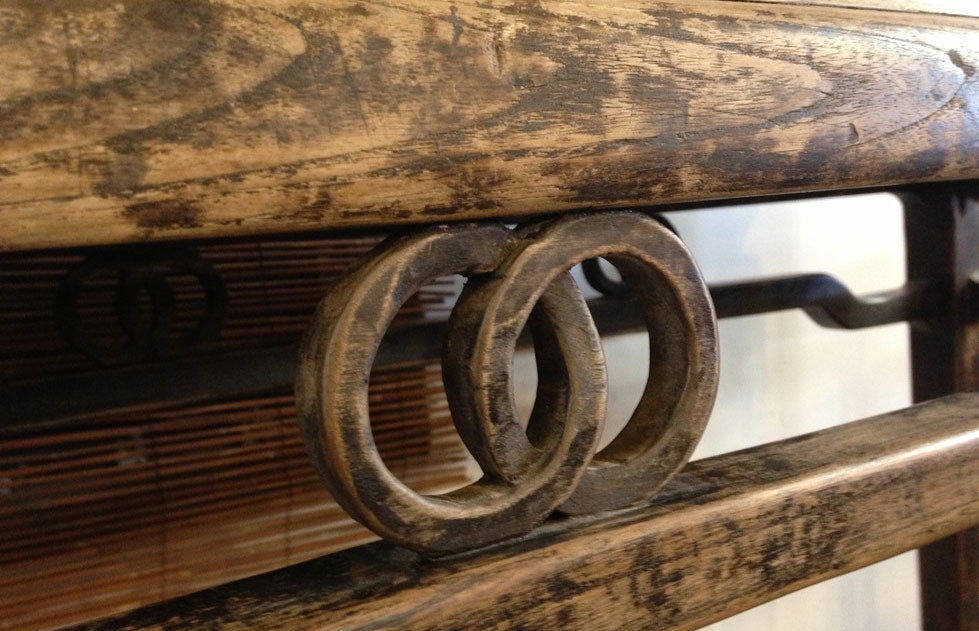
Beautiful Chinese antique furniture – a few highlights for our next container
I spent Thursday to Saturday here in Beijing visiting various furniture warehouses to select antique pieces for our next container. Over the three days I met up with another four or five suppliers, each one with a varying selection of antique furniture and reproduction pieces. As the number of good quality antiques has dried up over recent years, pretty much all of the companies that once dealt only in restoring antiques have moved into producing new furniture to a greater or less extent. In most cases the reproduction side of the business now represents over 50% of their offering and it is interesting to see the differing styles and finishes that each company specialises in. Whilst some are producing some very ‘natural’ looking solid wood furniture with a stripped back, minimalist finish, others are concentrating on painted and lacquered pieces in classic Chinese reds or blacks, with a shiny varnish. A couple have developed this type of finish further by using different and interesting coloured lacquers – even producing ‘patchwork’ style patterns of complementary colours on sideboards or multi-drawer chests. You should be seeing a few of these designs on our website soon as we included some on our last container, which were being photographed around the time I left the UK for China.
As well as a few suppliers that I have visited regularly on previous trips to Beijing, I also met up with the company that I had come across at the Shanghai fair last week. This was not a company I had come across before but their large warehouse showroom was certainly worth a visit and I left having ordered around 30 antique pieces to include on our container. Their business is around half antique and half new furniture. Although I didn’t order any of their new pieces this time around, I was impressed with the quality and attention to detail. Whilst they do produce some ‘natural’ finished furniture I have seen better elsewhere, but their speciality is lacquered and painted furniture with a classic, shiny finish. This they do very well and although we are short of space on our container this time around, we may well ship a selection of these pieces in the near future.
In the meantime I look forward to receiving the antiques I ordered from them, hopefully around early December. Amongst these are one or two really special pieces – ones that I have either not seen elsewhere or that are becoming increasingly rare. These included a beautiful large red lacquer cabinet from Shanxi province, still with its original circular hardware and with the original paintings of figures against a landscape in gold – the gilding technique known in Chinese as ‘Miao Jin’. There was also an interesting tall cabinet from Fujian province. This is not so old – dated around 1930 – but has some interesting paintings of various figures in period dress. It is signed by the artist, the characters for his name being inscribed on the chest of one particularly stern looking man painted on the right hand door, who stands with his hands on his hips as a lady looks on admiringly.
| Detail from 1930s Fujian Cabinet | Fujian Cabinet | Detail of Miao Jin paintings | Shanxi Red Lacquer Gold Painted Cabinet |
| Antiques awaiting restoration in Beijing | Shanxi Book Cabinet | Double Coin Detail from Elm Table | Antique Chinese Elm Table |
Earlier I had selected antiques from the two suppliers that I normally buy most of our collection from and, again, there were one or two items that stood out for me. A two hundred year old, beautifully made table in elm, with ‘double coin’ carvings around the aprons to bring prosperity, was one such piece. The quality of the carvings and construction of this table are more in keeping with finer, hardwood pieces of the time than with elm furniture and the finish is wonderfully smooth to the touch – certainly made by a highly skilled craftsman.
Another highlight was an unusual book cabinet from Shanxi, still with its original colour and finish, and sympathetically restored to give a very natural look. The cabinet has shelf space at the top for stacking books (the Chinese would put them one on top of the other rather than ends up as we do in the West), with two small drawers below and two doors at the bottom. The inscription on the left hand door reads something along the lines of ‘history books’ while the one on the right suggests the name of a place to read. The cabinet is made from ‘nanmu’ – a wood specific to China that was used for the furniture of the elite classes, suggesting that this cabinet belonged to a very wealthy family when it was made around 150 years ago.
Having chosen more than enough Chinese antique furniture to fill our next container (we will have to leave some in Beijing to wait until a later one), my last task was to visit a couple of markets, including the largest on at Panjiayuan, to pick up some smaller accessories. Amongst other items I lined up some nice stoneware, bronzes and ancestor paintings. Those of you who are fans of our selection of jewellery from the ‘Miao’ ethnic minority in China may also want to see some of the latest bracelets and necklaces, some of which I will be bringing back in my suitcase. The bracelets are silver plated and include inlays of brightly coloured embroidered Miao fabrics – very beautiful and great as Christmas gifts!
I’m now just about to leave for the airport for the long flight home. It seems a lot more than 11 days since I left Yorkshire but it has been an enjoyable and productive trip. We’ll try and have all the Chinese antiques that I’ve chosen while in Beijing up on the website in the next few weeks so keep checking. I’ll also post some up on our Facebook page when I get back to the UK, so if you want to be the first to take a look make sure you ‘like’ our page for notifications and I’ll be glad to hear what you think of the selection!













Leave a comment